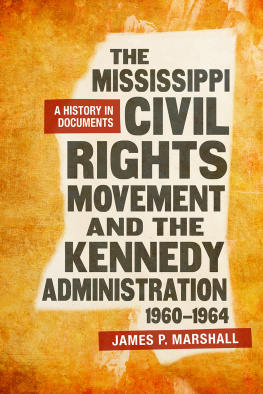The Price ofDEFIANCE
The publication of this book was supported by a
generous grant from the Watson-Brown Foundation, Inc.
2009 The University of North Carolina Press
All rights reserved. Manufactured in the United States of America
The following song lyrics have been reprinted with permission: Alma Mater, words and music by Michael McWhinney and Jerry Powell, 1963, 1964 by Alley Music Corp. and Trio Music Company, copyright renewed, international copyright secured, all rights reserved; Oxford Town, by Bob Dylan, 1963, renewed 1991 Special Rider Music, all rights reserved, international copyright secured.
Parts of this book have been reprinted with permission in revised form from the following works: The Closing of Mississippi Society: Will Campbell, The $64,000 Question, and Religious Emphasis Week at the University of Mississippi, Journal of Southern History 67 (May 2001): 33172; Thought Control in Mississippi: The Case of Professor William P. Murphy, Journal of Mississippi History 66 (Summer 2004): 15199; and The Fight for Mens Minds: The Aftermath of the Ole Miss Riot of 1962, Journal of Mississippi History (forthcoming).
Set in Minion by Keystone Typesetting, Inc.
The paper in this book meets the guidelines for permanence and durability of the Committee on Production Guidelines for Book Longevity of the Council on Library Resources.
The University of North Carolina Press has been a member of the Green Press Initiative since 2003.
Library of Congress Cataloging-in-Publication Data
Eagles, Charles W.
The price of defiance : James Meredith and the integration of Ole Miss / Charles W. Eagles.
p. cm.
Includes bibliographical references and index.
ISBN 978-0-8078-3273-8 (cloth : alk. paper)
1. University of MississippiHistory. 2. Meredith, James, 1933 3. College integration
MississippiOxfordHistory. 4. African AmericansCivil rights. 5. Civil rights
MississippiOxfordHistory. I. Title.
LD3413.E24 2009
378.76283dc22 2008047142
13 12 11 10 09 5 4 3 2 1
For Brenda, Daniel, and Benjamin
Toast to Ole Miss
Heres to Ole Miss who fluttered and flared and
cussed and sweared and tried to keep colored folks
out by hook or by crook, and loopholes they took in
the law, and indignations and proclamations and
brickbats to the jaw, showing off their bravery like in
slavery when white folks was the law and they could
knock a colored man down, right to the ground, and
he dare not fight back because he was black. But in
this day and time, things is not that way. A toast to
Ole Miss on Integration Day.
LANGSTON HUGHES, Chicago Defender,
October 27November 12, 1962
Contents
A section of photographs appears after page .
The Price ofDEFIANCE
Introduction
After his first night in his dormitory room, James Meredith rode in a riot-battered border patrol car to the Lyceum building at the center of the University of Mississippi campus. Escorted by agents of the U.S. Justice Department, he observed the debris from the previous evenings conflagration as he entered the Lyceum at 8:15 A.M. to register for classes. His enrollment on Monday, October 1, 1962, made him the first black student formally admitted to the school popularly known as Ole Miss, and indeed the first to breach racial segregation in the states system of higher education. The story of his struggle for admission to the all-white university also involves white Mississippis long defiance of racial change at Ole Miss.
Merediths venture at Ole Miss exhibited several characteristics atypical of other desegregation efforts. In his initial overture to the university, Meredith acted alone, not as part of any organized movement; only later did he receive assistance from the National Association for the Advancement of Colored People (NAACP). The evening before Meredith registered, his challenge precipitated a deadly riot on the university campus. The president of the United States deployed the army to restore order. The resistance to integration was so intense because Meredith waged his crusade in Mississippi, perhaps the most intransigently segregationist southern state, and because he targeted Ole Miss, an especially powerful symbol for white Mississippians. The most violent confrontation over school integration evolved from many complex historical factors, and it occurred at the University of Mississippi in 1962 for reasons peculiar to that time and place.
Merediths enrollment at the University of Mississippi completed a campaign that he initiated with his first letter to the university in January 1961. Though not at first sponsored by any civil rights group, Merediths quest became an important event in the wider black freedom struggle. During his service in the air force from 1951 to 1959, Meredith missed the emergence of the civil rights movement and its increasing momentum after the Brown v. Board of Education of Topeka Supreme Court decision and the Montgomery bus boycott. The movement that revolutionized race relations occurred unevenly across the South, and though Mississippi had a majority-black population as late as 1930 and the largest black population percentage of any state in 1960, the freedom struggle came late to his rural, recalcitrant home state.
NAACP branches had existed in Mississippi since the 1910s, but only after World War II did they begin to prove effective. In the late 1940s the state NAACP fought for equal pay for black teachers and for the right to vote for all blacks. Voter registration increased after the war, and NAACP branches developed in many towns across the state. Black indigenous activism increased, and after the Brown decision blacks took tentative steps toward school integration. Whites quickly retaliated. Started by Mississippi whites in the summer of 1954, the Citizens Councils waged a campaign of repression against any challenge to white supremacy and racial segregation. In 1955 the notorious lynching of Emmett Till evidenced the dominant power of whites. Between 1956 and 1959 ten blacks were killed by whites, and in 1959 Mack Charles Parker, charged with raping a white woman, was lynched in southwestern Mississippi. The violent, repressive tactics of white segregationists blunted the efforts of the NAACP, the Regional Council of Negro Leadership, and other black activist groups and delayed the emergence of the Mississippi movement. In her memoirs, Myrlie Evers, the widow of murdered NAACP leader Medgar Evers, maintained that the movement had stagnated in the backwater of Mississippi until the spring of 1961. In April of that year Tougaloo College students staged a sit-in at the Jackson Public Library, and the next month the Freedom Rides arrived in Jackson. The previous January, James Meredith had contacted the university and begun his assault on white supremacy.
By the time of Merediths application to Ole Miss, the long process of desegregating southern higher education had been underway for more than two decades. Begun in the 1930s, it had progressed slowly. Although nearly all southern colleges remained segregated at the time of the Brown decision, a few colleges in twelve of the seventeen southern and border states had desegregated. The admission of blacks occurred initially in graduate and professional programs, and first in the border and peripheral southern states. The University of Maryland law school enrolled a black student in 1936, and state universities in Oklahoma, Arkansas, and Kentucky desegregated in the 1940s. In 1950 the law schools at the University of Virginia and Louisiana State University admitted their first black students, and in 1952 the University of Tennessees graduate and professional program started to admit blacks. After the




